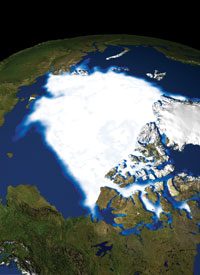
“The entire polar ice cap … could be completely ice free within the next five to seven years.” So claimed global-warming magnate Al Gore at last December’s UN Climate Change Conference in Copenhagen.
The scientist he referenced, Dr. Wieslav Maslowski, is a Department of Oceanography professor with the U.S. Naval Post-Graduate School. Maslowski denied making the prediction in an interview with the U.K. Times Online. “I would never try to estimate likelihood at anything as exact as this.” A shamefaced Gore admitted gleaning the “ballpark figure” from a conversation he had with Maslowski several years ago. Yet only days before Gore’s Copenhagen speech, the Danish Meteorological Institute (DMI) published a report of Maslowski’s research. It read, “Should the present trend of sea ice melt continue, some models suggest that the Arctic Ocean could become near ice free in the summer time within one decade.”
To further confuse things, DMI records show practically identical total sea ice area measurements in the Arctic for the past five years. However, DMI qualifies its data, noting that the age and thickness of Arctic ice is changing dramatically and citing research from the U.S. National Snow and Ice Data Center (NSIDC) in Colorado that Arctic sea ice is melting at a rate of 11.2 percent per decade. The NSIDC explains that more ice than usual has been melting in summer months during recent years. New ice cover is relatively thin, weak, and more vulnerable to melting. Remarking on the data, NSIDC Director Mark Serreze said, “We still expect to see ice-free summers sometime in the next few decades.”
Arctic Conditions
All this ice loss must mean the Arctic is heating up, right? On the contrary, DMI admits little difference in Arctic temperatures between 1958 and 2009, and data from NASA’s Goddard Institute for Space Studies (GISS) indicates a cooling trend in the Arctic since the 1940s. Indeed, some climate scientists — even those who support the idea of anthropogenic (human-caused) global warming (AGW) — are predicting Earth will experience a period of cooling for the next two or three dec-ades.
A top climate modeler with the UN Intergovernmental Panel on Climate Change (IPCC), Mojib Latif, said as much at last summer’s UN World Climate Conference in Geneva. A confirmed adherent to AGW, Latif explained that cyclical changes in the Atlantic and Pacific Oceans cause Earth’s temperatures to fluctuate between warm and cold modes every 20 to 30 years. He said we are at the beginning of a cooling period. The head of climate prediction at the U.K.’s National Weather Service (the Met Office), James Murphy, agreed and added that ocean cycles are contributing factors in the loss of Arctic sea ice. “The oceans are key to decadal natural variability,” Murphy said.
The head of the University of Wisconsin Atmospheric Sciences Group, Anastasios Tsonis, supports Latif’s findings with further evidence showing that global temperatures depend largely on oceanic “multi-decadal oscillations,” or MDOs. Tsonis does not deny human activities can contribute to rising temperatures, but he disagrees they can affect climate in any significant way. In an interview with the U.K.’s Daily Mail, Tsonis explained that the latest MDO warm mode has brought on the global-warming hysteria of the past few years. Recalling ice-age predictions made in the 1970s, he said, “Perhaps we will see talk of an ice age again by the early 2030s, just as the MDOs shift once more and temperatures begin to rise.”
So what explains Arctic ice loss in the face of a cooling Earth? Oceanographer Jane Eert attributes much of it to shifting winds she blames on climate change. She says the winds have exported “enormous amounts of ice” from the area. Yet she made the amazing assertion:
The guys who are running the long-term climate models have a tough problem. They’re looking at really long time scales, and as a result they can’t look at a lot of details for each year. In order to get the results before you die, you have to fudge some things. [Emphasis added.] And what they fudge is the small-scale stuff. But it turns out that probably the small-scale stuff is important, and fudging it gives you wrong answers.
Her “fudging” remark is particularly troubling in light of the Climategate scandal in which hundreds of e-mails pirated from a computer server at a leading research unit in England implicated many renowned scientists in fraudulently reporting data to favor their own climate-change agenda. In one of the messages, Kevin Trenberth, head of the Climate Analysis Section at the National Center for Atmospheric Research in Boulder, Colorado, said, “The fact is that we can’t account for the lack of warming at the moment and it is a travesty that we can’t.” Does this mean recent declines in Arctic summer ice are merely being exploited by scientists who have otherwise been unable to prove the efficacy of their climate models? Just how many wrong answers has their “fudging” produced?
Antarctic Conditions
Data collections at the University of Illinois confirm summer sea ice in the Arctic reached a 30-year minimum in 2007, but they also prove the largely unreported fact that summer sea ice spread in the Antarctic reached a 30-year maximum the same year. Researchers agree about the summer sea ice spread.
However, here is where consensus ends. Although most scientists seem to agree that the Arctic is losing ice, there is little agreement as to Antarctic conditions. Some say the Antarctic is stable, and others say it is melting like the Arctic ice cap. NASA satellite readings show West Antarctica “has been losing more than a hundred cubic kilometers (24 cubic miles) of ice each year since 2002.” NASA scientists attribute the loss of western ice to a decrease in mass due to warming waters causing ice shelf collapse. They ominously report, “Not much is going on in East Antarctica — yet.”
Nothing is likely to. The Norwegian Polar Institute (NPI) recently measured the temperature of sea water there and found it to be around the freezing point “and not at higher temperatures widely blamed for the break-up of 10 shelves on the Antarctic Peninsula.” NPI researcher Ole Anders Noest wrote, “This situation seems to be stable.” And, NASA scientists Marco Tedesco and Andrew Monaghan published a report of satellite data in the journal Geophysical Research Letters charting a 30-year minimum snow melt in the Antarctic summer (October-January) of 2008-2009.
Worst-case Scenario
Regardless of whether, where, or how much ice is melting, total global sea ice extent in the past 30 years shows practically no trend, with 2008 and 2009 peak sea ice seasons equivalent to the 1979-2000 mean.
But consider for a moment a worst-case scenario. What would happen if all of the Arctic sea ice melted? “Sea level would not rise by so much as a millimeter,” said Lord Christopher Monckton, former U.K. science advisor to Prime Minister Margaret Thatcher. Just as melting ice cubes in a glass of water don’t make it overflow, melting sea ice does not affect sea level.
Monckton is not alone in claiming Arctic ice melt poses no threat. Roy W. Spencer, a former NASA scientist, points out glaciers have been retreating for more than 100 years, well before the dawn of the Industrial Age. “A few retreating glaciers are even revealing old tree stumps,” he writes on his blog. “How did those get there? Planted by skeptics?” Obviously, if retreating glaciers expose tree stumps, then these glaciers could not always have been there and are not shrinking to unprecedented sizes.
Spencer was among 170 scientists from around the world who signed an open letter to the UN Secretary-General prior to the Copenhagen Climate Conference, calling for “convincing observational evidence” to support claims of dangerous AGW. Among the itemized list of alarmist assertions they challenged was “worldwide glacier retreat, and sea ice melting in Polar Regions, is unusual and related to increases in human GHG [greenhouse gas] emissions.” In other words, 170 highly qualified scientists stake their professional reputations that melting polar ice caps pose no threat whatsoever.
The Sky Isn’t Falling
Perhaps the most significant factor to consider is the following report (excerpted) from the federal National Oceanic and Atmospheric Administration’s (NOAA) American consul at Norway, George Ifft:
The Arctic seems to be warming up. Reports from fishermen, seal hunters, and explorers who sail the seas about Spitzbergen [an island 12 degrees south of the North Pole – ed.] and the eastern Arctic, all point to a radical change in climatic conditions, and hitherto unheard-of high temperatures. In fact, so little ice has never before been noted. The warmth of the waters makes it probable that the favorable ice conditions will continue for some time.
Many old landmarks are so changed as to be unrecognizable. Where formerly great masses of ice were found, there are now often accumulations of earth and stones. At many points where glaciers formerly extended far into the sea they have entirely disappeared. The change in temperature has also brought about great change in the flora and fauna of the Arctic. There were few [white fish and] seal in Spitzbergen waters this year, and last winter the ocean did not freeze over even on the north coast. With the disappearance of white fish and seal has come other life in these waters. This year herring in great shoals were found along the west coast. Shoals of smelt were also met with.
Ifft’s report appeared in NOAA’s Monthly Weather Review of November 1922. Whatever caused the “favorable conditions” in 1922, it is certain man-made greenhouse gases had nothing to do with it, and the rest of the world went on with the political and cultural revolutions of the 1920s without noticing any catastrophic climate change.
Of great interest is Ifft’s comment that the unprecedented melting brought about “favorable ice conditions” everyone hoped would “continue for some time.” In the report Ifft also detailed an expedition made that summer which set a record, “sailing as far north as 81? 29’ in ice-free water.” Ifft published a follow-up report in the December edition of the same publication in which he explained researchers credited sun-spot and oceanic cycles with the “exceptionally favorable ice conditions.”
Al Gore’s “The ice is melting!” rant deserves as much attention as Chicken Little’s “The sky is falling!” The problem is he and other global-warming alarmists are getting as much attention as Chicken Little did. And while the fabled fowl was only trying to be helpful, the unscrupulous intent of global-warming alarmists is to set up an energy-regulating global government and an international carbon-trading market worth billions. Even though polar ice conditions are far from unusual or dangerous, these climate tycoons have far too much at stake to ever admit the sky isn’t falling and humans aren’t to blame. The public would do well to remember when Chicken Little’s friends joined in her hysteria, they ended up as dinner in the fox’s den. Unless countered through sound facts and reasoning, global-warming hysteria will end with much the same fate.
Ed Hiserodt contributed to this article.




